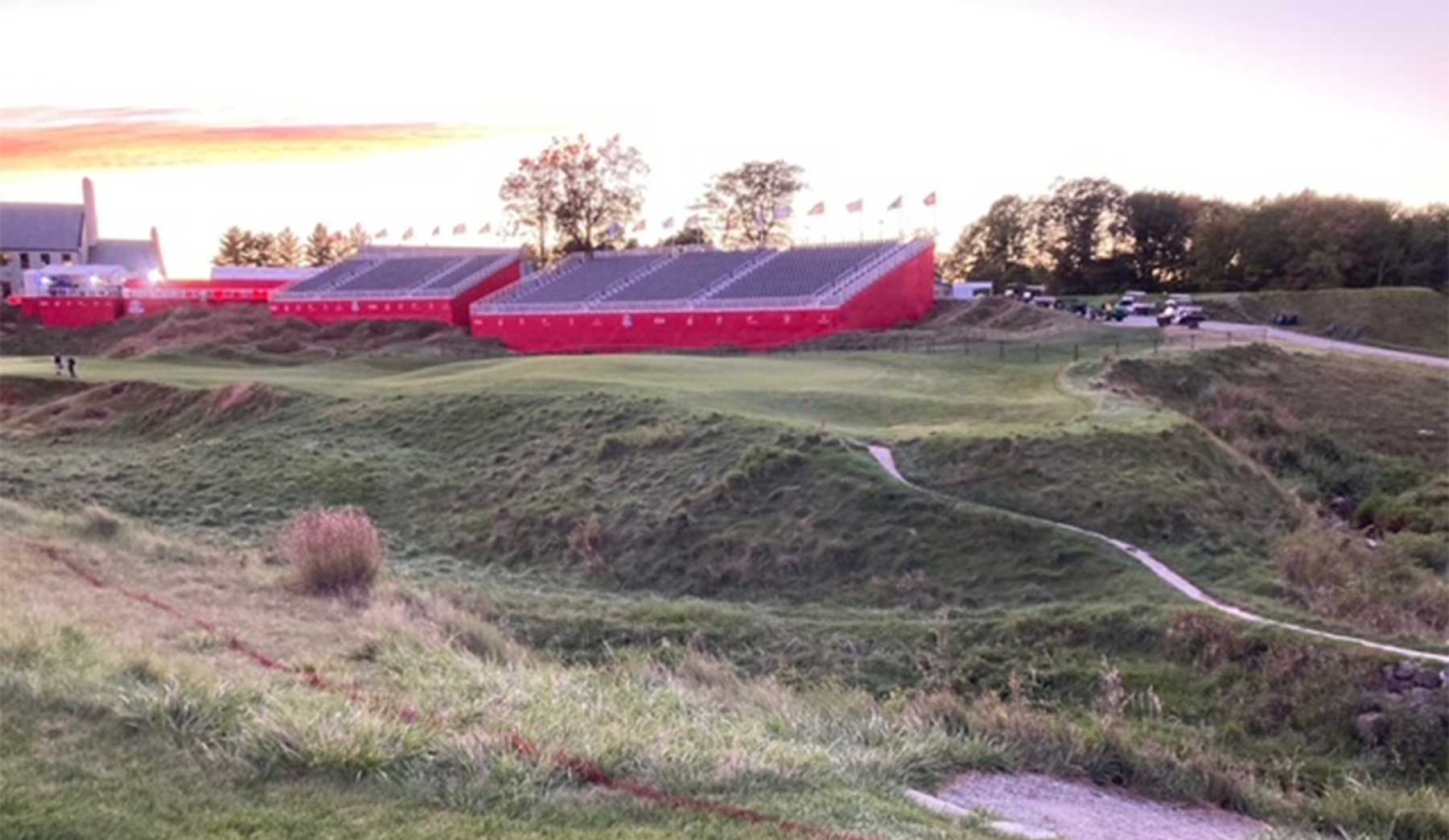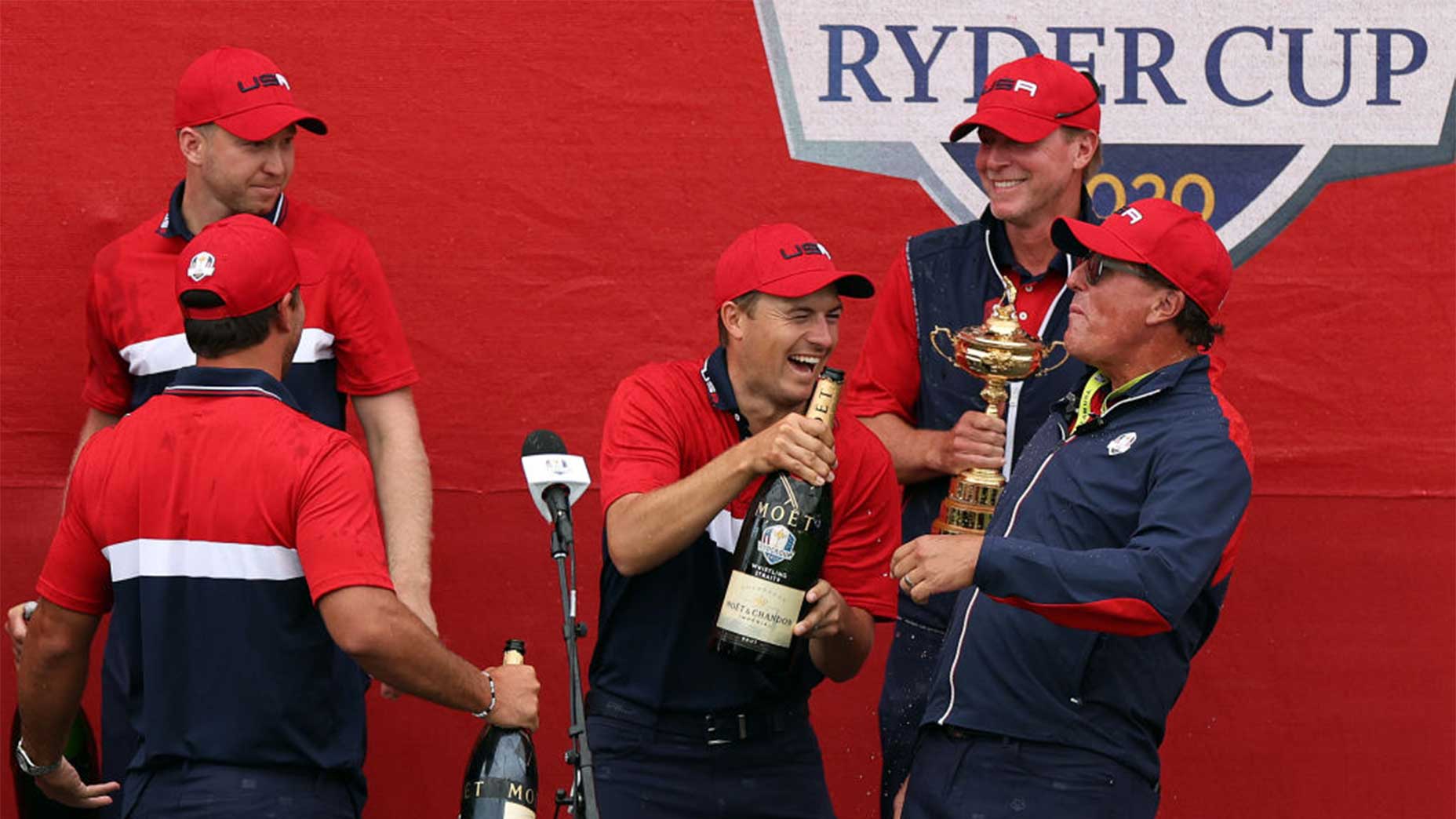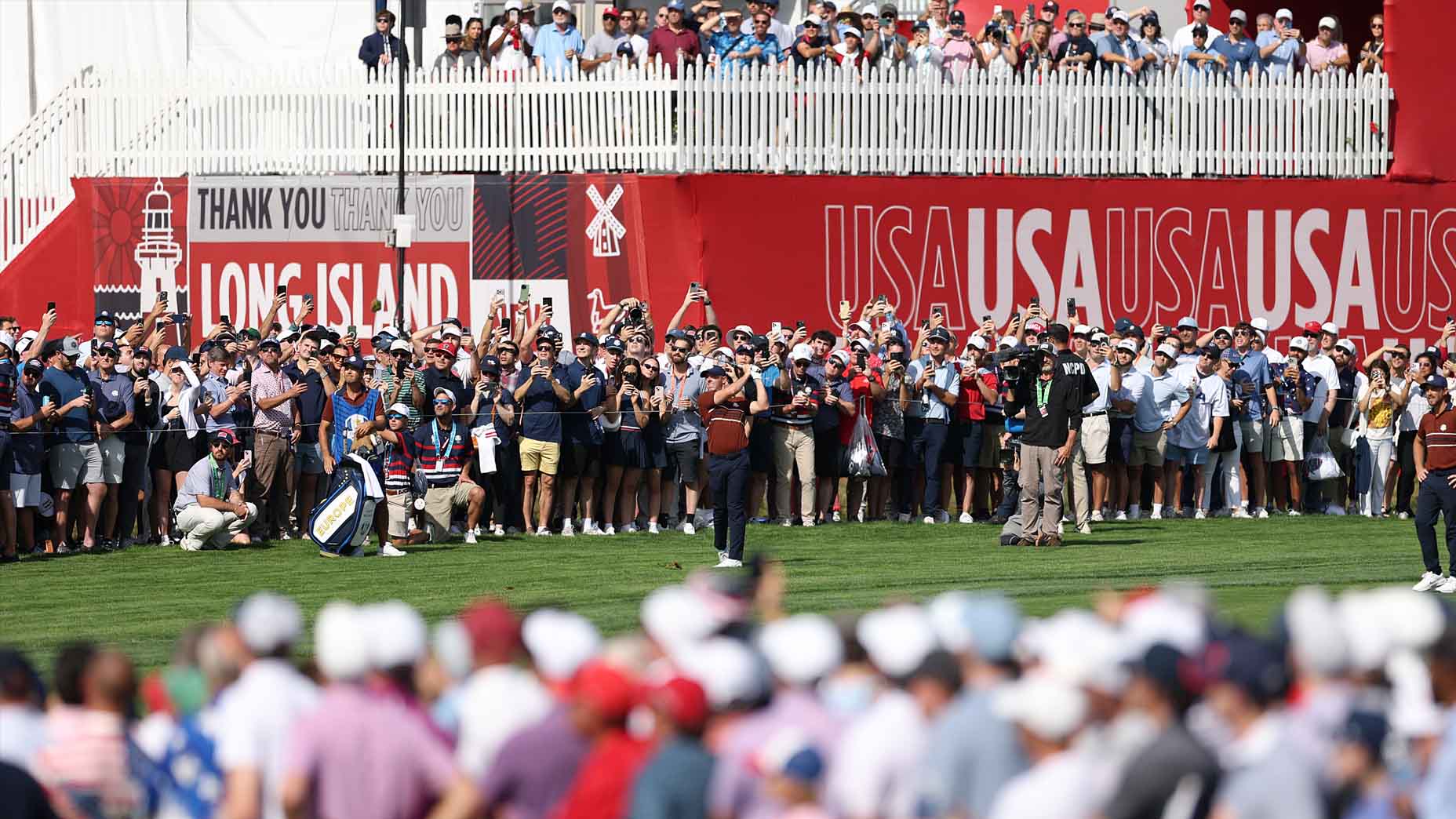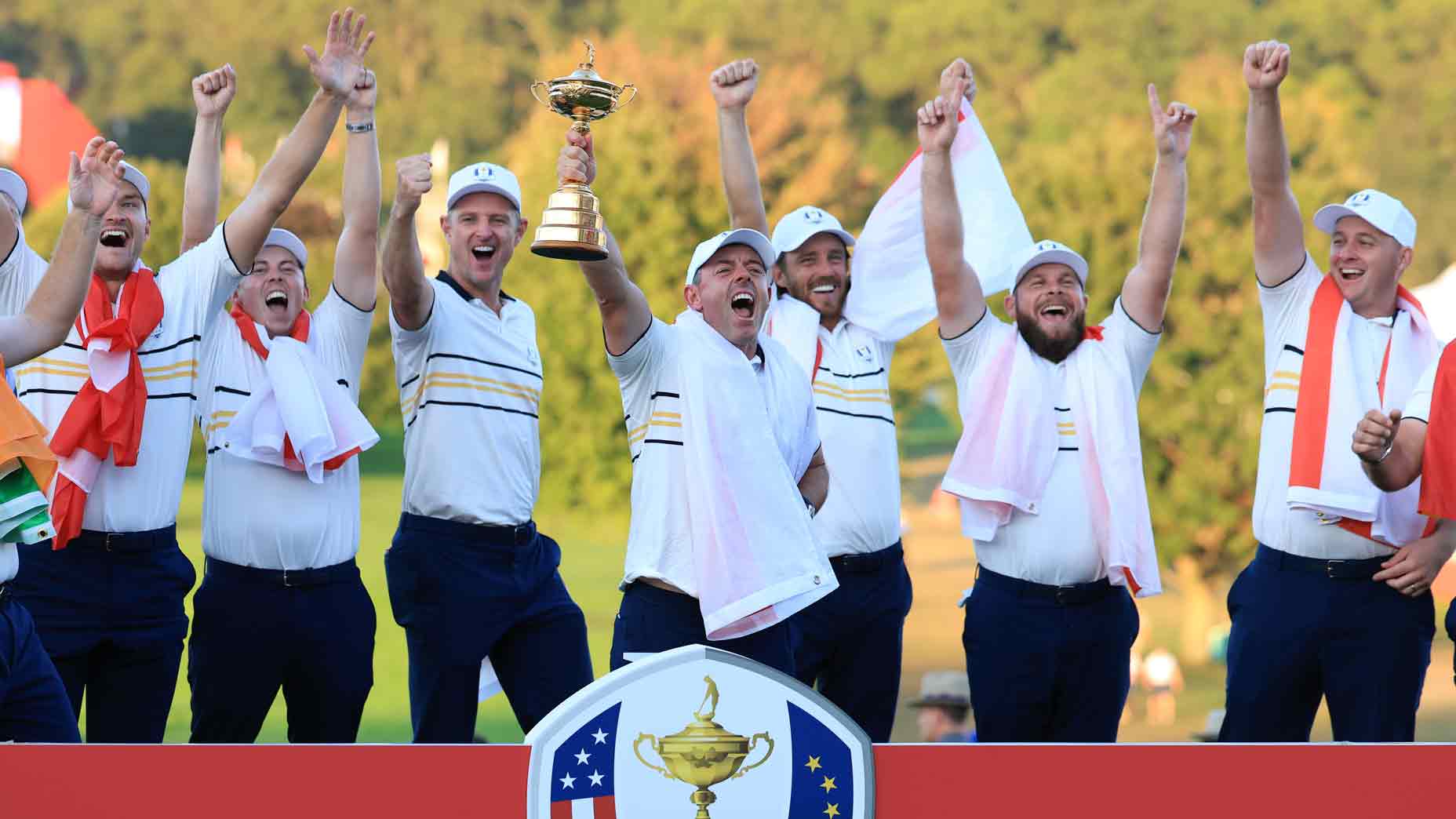What did our on-site staffers learn after a week at Whistling Straits and the 43rd Ryder Cup? We asked them for their takeaways from Haven, Wis., in this edition of “Notebook Dump.”
The presence of Tiger Woods
Tiger Woods wasn’t at Whistling Straits last week but his presence, as ever, was felt. On Monday, U.S. captain Steve Stricker said that Woods is “in my ear a lot and I call him pretty regularly. He’s part of our Ryder Cup team. He’s part of what we do.” During a Tuesday practice round, an American fan donned a T-shirt covered in images of Tiger’s greatest moments, scrapbook-style. On Wednesday, Woods sent a motivational text to the troops: something along the lines of, and we’re paraphrasing here, “Drop the hammer on ’em, boys.”
Eight miles south of Whistling Straits, more Tiger, in photo form, on the wall at a mom-and-pop Italian restaurant called Luigi’s. Caprese, stuffed shells, eggplant parmesan with a mean red sauce — Luigi’s serves all your faves, as Woods discovered when he visited the eatery in 2004, during PGA Championship week, with his then-wife Elin Nordegren, pal Mark O’Meara and an unidentified fourth diner. They sat at a booth tucked away in the back corner. Tiger and Marko split an extra-large sausage and pepperoni pizza; Elin had the fusilla primavera. No bill followed. Dinner was comped by Luigi’s owner, Umberto Vitale. As a token of his gratitude, Woods left behind $20.
Also dining at Luigi’s that evening was another golfer of note, Phil Mickelson. When Mickelson paid his bill, he added an $86 tip, a playful nod, presumably, to that week’s event, the 86th PGA Championship. Woods and Mickelson are both destined to be named Ryder Cup captains. Best guess for Mickelson is 2025 at Bethpage; Woods’ turn will follow soon thereafter.
They will helm their teams with markedly different styles. — Alan Bastable

The key to a good Ryder Cup pairing
What makes a good playing partner? That’s a question I was wondering all week, and with every rumbling of a potential pairing, curiosity struck again.
Golfers, coaches and golf fans are smarter now than ever, and you could see the beauty of human advances at play this week. Throughout the contest, we were treated to a steady flow of partnerships that, on paper at least, were optimized statistical matches. Some of them came to bare and undoubtedly worked (DJ-Morikawa). Others, not so much (Westwood-Fitzpatrick). There’s something intuitive and appealing about meshing two players together whose games are very similar in the tactical battle of the Ryder Cup.
Yet ask the players themselves, and they sing a different tune.
“It’s important to put two personalities together, two friends together, two guys that get along,” said Justin Thomas.
“You want to play with somebody you would take a bullet for,” Tommy Fleetwood said.
Ryder Cup legend Tony Jacklin, Europe’s most winning captain in history, said the essence of his best pairings were a product.
“Whether two players personalities mesh is far superior to everything else,” he says. “They have to build that sense of trust with one another. … If you don’t have that, you have nothing.”
This Ryder Cup, in many ways, brought to bear this truth. In the technologically driven world of golf, it was the intangible skills — a sense of unity, friendship, trust and togetherness — that reigned supreme at Whistling Straits. — Luke Kerr-Dineen
A pre-Ryder Cup stroll
Later, the course would be loud. Michael Jordan, his meaty hands over his head, clapping. Jordan Spieth and Jon Rahm’s caddie, jawing. A flatbed golf cart, packing ice, the lady driver trying to get through a knot of people otherwise engaged: “Behind you; behind you, please; right behind you.”
But early one night — before the first shot was hit in anger, the sun hanging on and showing off — Whistling Straits was empty and still. You could walk the course, right down the middle, in this calm before the storm. You could imagine what it would be like, to be them. The course — the inward nine — as the players see it. Not from a drone or a TV camera or a yardage book, but on their own two feet. The course in their minds.
The narrow, mown path, bordered by rough on either side, coming off the 10th tee. The nasty bunker on the right side of 11, a monster par-5, a hit-here-and-pay pit for wayward second shots where birdie chances go to die. The heaving, wavy green on the par-3 12th, mimicking the ocean behind it. That is an ocean, right?
The tee shot on 13. Aim left. A slice drive in a slice wind could land in the ocean. The subterranean loo underneath the 14th tee. Real doors, real running water, real fixtures. Last best chance from here to the house. The corporate tents on 15, they who pay the bills. NBC Sports, Kohler Co., Johnsonville Qualtrics. Baird, whatever that is. Milwaukee Tool, U.S. Bank. American Family Insurance. Ferguson. Not Doug — not the AP golf writer.
Juniper bushes on 16, in play. Lost ball waiting to happen — feel like I’m at an Open. A giant scoreboard near the 17th tee that, later, will track the march to 14.5. Nil-nil, for now.
To 18. Tee box to fairway to downhill path. Across a bridge and over a creek, up a hill, to the green, the clubhouse behind it. Grandstands on the right. Empty, but only for now, in this Midwestern gloaming. Come Friday, come Saturday, come Sunday, they’ll be packed. The Ryder Cup, the Ryder Cup, the Ryder Cup. Loud is coming.
Right call, waiting the year. The reason we’re here. — Michael Bamberger

‘You’ve got many of these left ahead of ya’
We saw a lot of European tears last week. Infinitely more than we saw from the Americans in 2018. A conversation about that difference could last 30 seconds, or 30 minutes.
Lee Westwood’s career as a Ryder Cup player is basically over, and that’s sad. Ian Poulter’s might be as well. Paul Casey’s, too, perhaps. He’s 44, and despite his teammates assuring him he’ll be there in two years, there are no givens. Unless your name is Jon Rahm or Viktor Hovland.
It was fun to sit, stand and walk in Hovland’s orbit after his gutty tied match against Collin Morikawa Sunday afternoon. It was one of those matches that will be lost forever in the fescue at Whistling Straits, and probably won’t hold an ounce of meaning to Morikawa. But it could mean a lot for the 24-year-old Hovland.
The Norwegian was too steamy for tears Sunday afternoon, but when the idea of future European teams hit the press conference, captain Padraig Harrington listed just two players. Hovland and Rahm. Matthew Fitzpatrick, 27, sat in the front row with his chin on his chest, still winless in his Cup career. That omission was brushed over, and it may have been accidental, but it happened nonetheless.
A much longer list of people beelined for Hovland in the final hours of this Cup. Sergio Garcia came first, just behind the 18th green. Then Bernd Wiesberger. Then Casey, with some advice about how to feel in these moments: “You always think you can do more. You always want to give more.”
After doing battle for four hours, Morikawa’s caddie, J.J. Jakovac, put his hand on Hovland’s shoulder and spoke loud enough for everyone to hear: “This guy drives it like Jesus Christ himself.”
10 things from the Ryder Cup that you wouldn’t have seen on TVBy: Dylan Dethier
He kinda does.
An endless stream of caddies, wives, physios and swing coaches reached Hovland at some point late Sunday. Everyone is proud of him, of course. He played five matches, but won zero. He steamed about it a bit afterward. As he reached the top of the steps near the clubhouse, though, the most important hug was still waiting. “I’m so proud,” Harrington said softly into Hovland’s ear. “You’ve got many of these left ahead of ya.” — Sean Zak
The U.S. Ryder Cup team delivered, and so did Wisconsin
Ryder Cup Week has a strange pacing: it moves slow, and slow, and then suddenly fast, with a landslide of matches from dawn on Friday to dusk on Saturday. For those of us on site that means early mornings and late nights, plus the reality that our coverage of a given session — say, Friday’s afternoon matches — is quickly replaced by the next on-course action. (Those of you reading are encouraged to begin tuning your tiny violins.) Figuring out how to split time between the course (reporting!) and the media center (typing, and fast!) is a constant challenge.
The calmest stretch of the week came on Sunday morning, when the first tee time was a hospitable 11 a.m. That meant a morning jog from our digs down a country road, dead-straight one way, dead-straight back, cornfields on either side. The Midwest! Sean Zak and I certainly didn’t match the 10-mile jog put forth by Michael Bamberger, but still — every bit counts, particularly when the media center has unlimited M&M cookie sandwiches. Sunday morning meant getting some shots up on the hoop in the front yard of our wooden A-frame cabin. And it meant a plunge in Lake Michigan, an icy 59 degrees, a welcome shock to the system. Then it was off to see the Americans do their thing.
When I think back on covering golf tournaments my mind skips through the events themselves but inevitably settles on the setting itself, and the experience of being there. How was the Airbnb? Eclectic and wonderful. How was the commute? Apart from Friday morning’s traffic jam, calming and smooth. How was the company? They’re reading this, so I’m obligated towards a complimentary description.
In total, rural, lakeside Wisconsin delivered in a big way. Whistling Straits delivered in a big way. And when it comes to starting your day off right, a morning jump in the lake is undefeated. — Dylan Dethier











